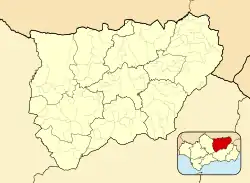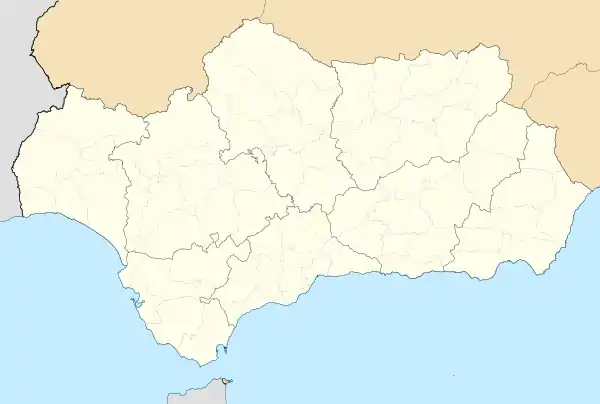La Carolina
La Carolina is a city and municipality located in the province of Jaén, Spain. According to the 2014 census,[2] the municipality has a population of 15,808 inhabitants.
La Carolina | |
|---|---|
 Seal | |
 La Carolina Location in Spain  La Carolina La Carolina (Andalusia)  La Carolina La Carolina (Spain) | |
| Coordinates: 38°16′N 3°37′W | |
| Country | |
| Autonomous community | |
| Province | Jaén |
| Municipality | La Carolina |
| Area | |
| • Total | 201 km2 (78 sq mi) |
| Elevation | 595 m (1,952 ft) |
| Population (2018)[1] | |
| • Total | 15,306 |
| • Density | 76/km2 (200/sq mi) |
| Time zone | UTC+1 (CET) |
| • Summer (DST) | UTC+2 (CEST) |
History
La Carolina was formerly the capital of the Intendencia of the Nuevas Poblaciones de Andalucía y Sierra Morena founded in this formerly remote and desolate area of the Sierra Morena in 1767 by King Charles III. The object of the plan, drawn up by his minister Pablo de Olavide, administrator of Andalusia, was to populate the area around Despeñaperros gorge. Known as "the gateway to Andalusia"; this pass was a notorious point on the Cádiz-to-Madrid royal highway for bandits. Other towns of note in this plan were La Carlota and La Luisiana. The Intendencia administrative division was wrapped up in 1813.[3]
Six thousand Catholic settlers arrived from Belgium, Germany, Austria and Switzerland to take advantage of the generous offers of land and livestock being made to colonizers (five chickens, five goats, five sheep, two cows, and a sow per family). With a few years, about half of them had died from illness or gone home: the rest gradually lost their national identities over the years, and took on the language and customs of their host country. One can still find people in this area with Germanic surnames such as Eisman, Minch, Clap, Smidt, Ming and Kobler.
The town's relatively recent history, as well as its northern European target population, explains its unusually regular, colonial-style grid layout, with wide avenues, as opposed to the more common winding narrow streets typical of the Moorish-patterned towns in Andalusia.[4]
Became later part of Jaén Province
- Aldeaquemada
- Arquillos
- Carboneros
- La Carolina
- Concepción de Almuradiel
- Guarromán
- Miranda del Rey, a village of Santa Elena municipality
- Magaña-Montizón, Magaña is a village of Santa Elena municipality[5][6]
- Navas de Tolosa, a village of La Carolina municipality
- Santa Elena
Became later part of Córdoba Province
Notable people
- Custodia Romero (1905-1974), flamenco dancer and actress
References
- Municipal Register of Spain 2018. National Statistics Institute.
- Instituto Nacional de Estadística (INE)
- Colección de los decretos y órdenes que han expedido las Cortes Generales y Extraordinarias, 24/02 - 14/09 de 1813, Tomo IV, Decreto CCXLIII, de 2 de marzo. Se suprime la Intendencia; medidas para la formación de sus ayuntamientos y designación de su territorio, dehesas, etc.
- Andalucia - La Carolina
- Despeñaperros (Jaén): Magaña, cara norte del Muradal
- Madoz; Magaña - Historia